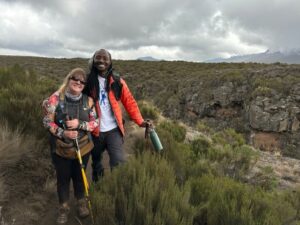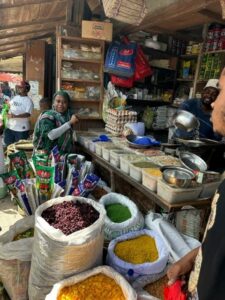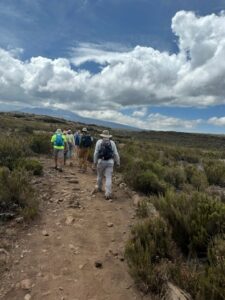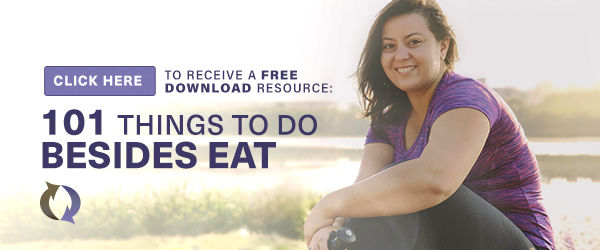One of the best things about travel is the opportunity to observe and learn from and about other cultures.
We gathered many lessons from Tanzania about body size, food, and time during our recent Am I Hungry? retreat. (And for photos of our safari, visit the Am I Hungry? Facebook page!)
Larger body size is healthy and attractive
One remarkable example of a cultural difference is how bodies are viewed in East Africa compared to Western culture. Seeing body size through a different cultural lens was a good reminder that body image is more about perception than body size.
 During our Am I Hungry? Mindful Eating Retreat in Tanzania, Larick and Stephanie (aka Badger) who operate Dirty Freedom Adventures, our hosts for our safari and Kilimanjaro climb, shared their perspectives on how bodies are perceived there.
During our Am I Hungry? Mindful Eating Retreat in Tanzania, Larick and Stephanie (aka Badger) who operate Dirty Freedom Adventures, our hosts for our safari and Kilimanjaro climb, shared their perspectives on how bodies are perceived there.
Stephanie is from the U.S. and has been living in Tanzania for seven years; Larick was born and raised there. (Read Stephanie’s inspiring story, Food wasn’t my problem, it was my symptom!)
Larick shared that in Tanzania, larger bodies are generally seen as healthier and more attractive, whereas thinner bodies are seen as less healthy or even ill.
When he met then later married Stephanie, his friends and family approved of her body size, something she had struggled with in the U.S. After moving to Tanzania and eating differently, Stephanie lost some weight. Larick’s family was concerned and accused him of not taking care of her or feeding her well! They were concerned that she wasn’t as healthy as she had been.
How very different from how bodies are perceived in Western culture!
Our group asked Larick what he thought caused this difference. He thought it was probably due to the association of lower body weight to illnesses (such as HIV), malnutrition, and poverty.
Eating style is very different in Tanzania
There were also many notable differences in the way people ate. Besides the expected differences in their traditional foods, Larick said that food storage is a huge problem, so most people buy and consume their food on the same day.
 In Arusha and Stone Town, we didn’t see any grocery stores like we have here. We saw and visited open-air markets with displays of produce, fish, meat, live and butchered poultry, as well as bulk rice and beans, and dried spices. One “convenience” store had the more familiar shelves, but on closer inspection, we realized that each shelf offered only one brand of one product! In the U.S., we take the availability of countless options for granted.
In Arusha and Stone Town, we didn’t see any grocery stores like we have here. We saw and visited open-air markets with displays of produce, fish, meat, live and butchered poultry, as well as bulk rice and beans, and dried spices. One “convenience” store had the more familiar shelves, but on closer inspection, we realized that each shelf offered only one brand of one product! In the U.S., we take the availability of countless options for granted.
Stephanie also noted that sweets and desserts aren’t really “a thing” in Tanzania (and for her, this sometimes leads to cravings for foods that were readily available back home).
We observed that there were no fast food restaurants anywhere we went! Not one, unless you count the various street food carts (which we were strictly advised to avoid).
We also noted a lack of vending machines at the hotels, which one retreat participant attributed to the lack of urgency about having food available 24/7. (This is in sharp contrast to The Abundance Paradox I’ve previously written about.)
Having said that, all the lodges and tented camps we stayed at catered to tourists. All our meals were generous and delicious and provided a variety of fresh flavors!
A slower pace
Before our trip, we were advised (warned?) to expect a slower pace and that unexpected delays and changes to plans are the norm, so “patience is one of your most valuable assets while visiting here!”
 On arrival, we were soon introduced to “Africa time.” This casual approach to time was a welcome part of the experience for me! When adherence to departure times was essential, we were told to observe “American time.”
On arrival, we were soon introduced to “Africa time.” This casual approach to time was a welcome part of the experience for me! When adherence to departure times was essential, we were told to observe “American time.”
More than once, we heard the phrase “pole, pole,” slowly, slowly. This is the pace used to summit Kilamanjaro, allowing the body to adjust to the increasing altitude during the climb.
Pole, pole also described the wonderfully leisurely pace for our 6-day safari. We made our way through Tarangire National Park, Ngorongoro Crater, and the Serengeti, pausing frequently to observe the amazing diversity of wildlife!
One of our safari guides shared the saying: “If you walk, we walk together. If you run, you run alone.”
Something for everybody!
 With so much to see and do, we decided to include a one-day hike on Kilimanjaro to get a small taste of the experience. (The full hike to the top is typically seven or eight days.)
With so much to see and do, we decided to include a one-day hike on Kilimanjaro to get a small taste of the experience. (The full hike to the top is typically seven or eight days.)
There were 13 of us at different levels of fitness and abilities, along with six porters and guides (there’s even more for longer hikes!).
We started our hike together then spread out to three groups: A faster, challenging hike to Shira Cathedral; a moderate level hike with more time to take in the views; a slower group that was able to proceed with more caution yet still made it to Shira Camp!
No matter which pace each hiker chose, no one was left behind and everyone felt appropriately challenged!
So much to see, do, and learn during this amazing Tanzania Adventure!
Enjoyed this article? Here are three more to help you:
The Italian Treadmill: Do What You Love, Love What You Do
Mindful Eating on Vacation – Ask Am I Hungry?
Sensuous Eating: Make eating a multisensory experience


